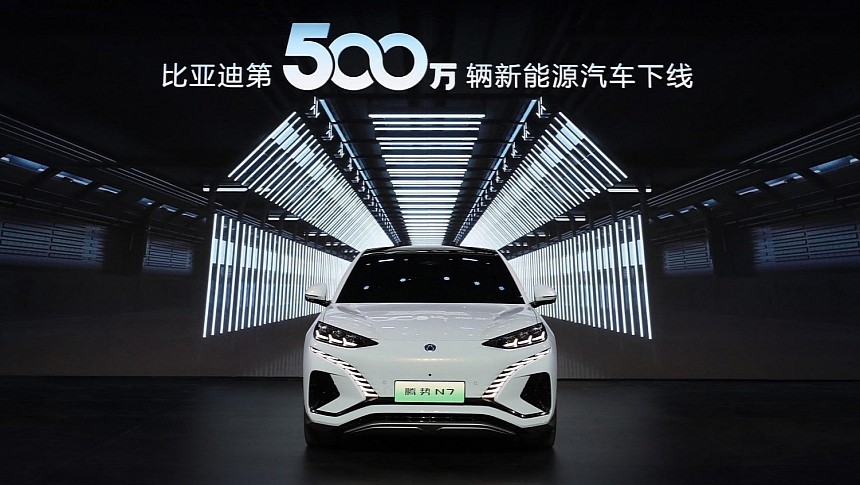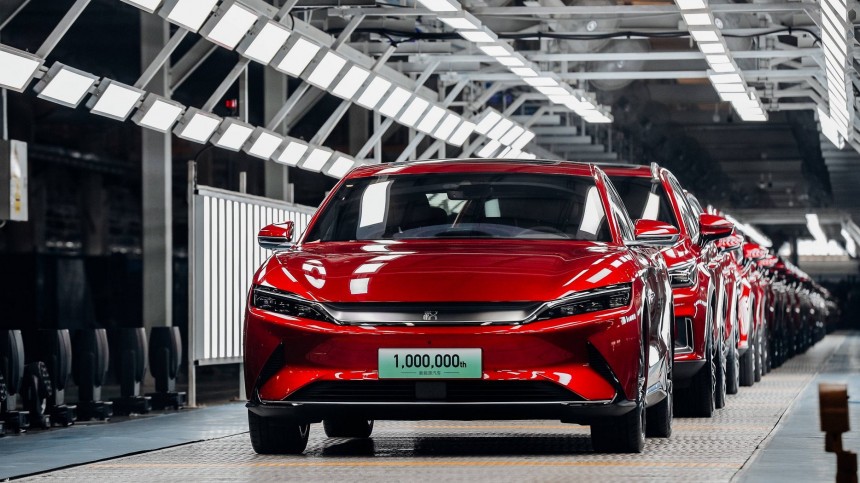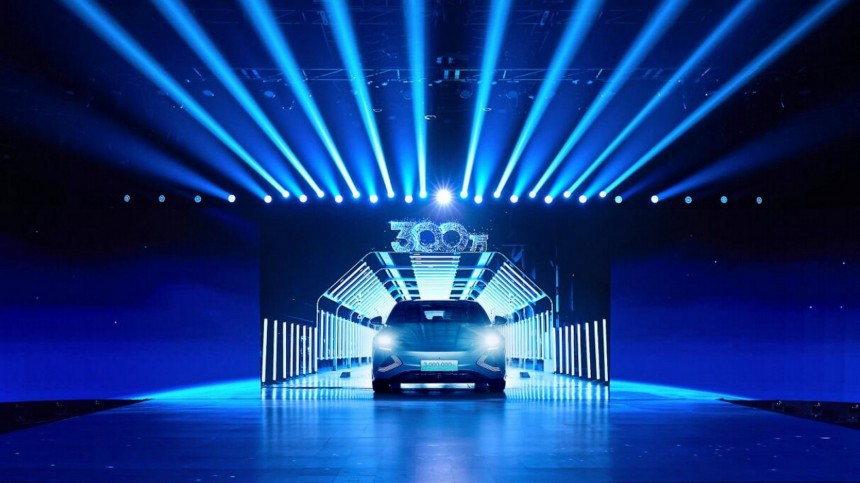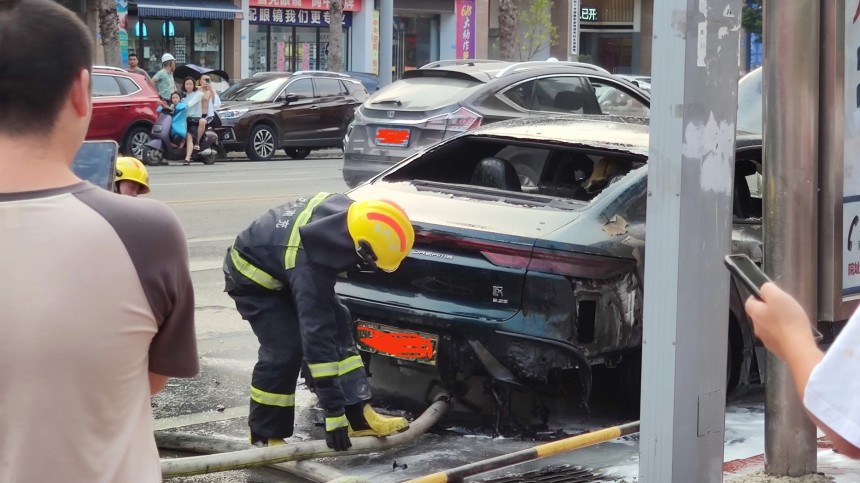I have written more than once about how Tesla established the battery electric vehicle (BEV) model that all automakers follow nowadays and how that standard may be flawed. The company was the first one to use thousands of ternary cells to create a battery pack. Although they were the most energy-dense cells available at the time – and still are until we come up with something better – they are fragile and prone to thermal runaways, as Our Next Energy once warned. What if more reliable chemistry helped deliver BEVs? That's what BYD Auto may be willing to show after selling five million new energy vehicles (NEVs).
The Chinese automaker was founded in 2003 but only produced its first new energy vehicle (NEV) in 2008. It was the F3DM, the world's first mass-produced plug-in hybrid vehicle (PHEV). BYD would only make a battery electric vehicle (BEV) in 2011, starting with the e6 MPV. Although both models already used LFP cells, it was only after developing its Blade Batteries that BYD decided to step on the accelerator pedal with manufacturing. And what a push it was!
BYD took 13 years to reach its first million NEVs, a market category that includes BEVs and PHEVs. Add 13 to 2008, and you'll travel to 2021. During that time, it tried to compete with legacy carmakers in their territory. In other words, with internal combustion engine (ICE) vehicles. BYD eventually gave up on cars powered exclusively by fuel in March 2022, which does not mean it does not keep an eye on that tech. The company created the world's most efficient ICE for its plug-in hybrids until Geely beat it. The Xiaoyun could turn 43% of the chemical energy contained in gasoline into movement. The Geely DHE1.5 engine marginally beats that with 43.32% thermal efficiency. However, let's rewind a bit.
The Chinese automaker announced Blade Batteries in March 2020. Like LFP cells, they are made from relatively abundant raw materials, are not as subject to thermal runaways, and can work as structural components in a cell-to-pack (CTP) or even cell-to-body (CTB) construction. That allows them to offer more energy density, which is one of the issues with LFP cells. BYD is particularly proud of nail penetration tests in which Blade Batteries did not catch fire or emitted smoke. Summing up, they could support the production of high-volume BEVs at more affordable prices than those vehicles with ternary cells can cost.
The first car to use them was the Han EV, released in July 2020. It helped the company get to its first million NEVs sold by June 2021 and also speed up that market offensive: 18 months later, BYD reached 3 million NEVs. That happened in November 2022. It took BYD only nine more months to reach 5 million NEVs, which shows how fast the company is managing to sell new cars, both in China and abroad.
The company's performance in its home market would already be enough for the incredible growth rate it presented. BYD was the first native carmaker to beat Volkswagen there in the first half of 2023. Remember that China is the world's largest car market. If sales continue to increase, BYD will be the country's best seller in 2023. As symbolic as that is, the company does not want to rely solely on its own backyard to reach the end of the year with an even higher sales figure.
BYD announced new factories in Brazil, Thailand and the intention to have them in Europe as well – more than one. It has five more in China dedicated to NEVs. BYD is already selling its vehicles in a multitude of new markets, even if sales are slowly increasing. In several markets, only reservations for its more affordable cars are open: deliveries will still take a while. The company now has a lineup composed of three series: the e Series, with five models; Dynasty Series, with ten options; and the Ocean Series, with nine models. The Dolphin and the Seagull are the cheapest offerings in the Ocean Series, even if the Dolphin disappointed those who expected the same affordability in Europe that it offers in China.
The bottom line is that BYD waited years in stealth mode until it had a battery that could sustain its expansion ambitions. It built factories in China to produce its cars, buses, trucks, and cells, which turned it into one of the largest battery makers in the world. Tesla is buying BYD batteries to make its cars in Germany, which means that each German Model Y with an LFP battery pack also puts money in BYD's pockets. That's a level of planning and anticipation that no other new car company came even close to presenting – even legacy automakers are lacking it, to be honest.
With these cheaper cells and a wide variety of products, BYD may beat something Axios pointed out as the next hurdle for BEV adoption: the early adopters' era is over. In other words, those who had money to buy these cars and not depend on them should anything go wrong already have them. The next ones in line are those who make calculations to buy anything, particularly more expensive goods like automobiles, and those who can't afford to have three or more cars at home. Summing up, those who will not be so forgiving with poor build quality, with getting stranded anywhere due to insufficient range or lack of chargers.
BYD sells PHEVs with a pretty reasonable electric range for daily needs, able to make road trips with fuel. It also has affordable new BEVs for sale that can be charged to 100% as often as their drivers want. Ternary cells have charging restrictions: you should never charge above 90% and should never allow it to drop below 20%. For people that just want to charge and drive, this is the sort of care that will deter purchase.
As great as things look for BYD, it had some blaze episodes with its vehicles that it failed to explain. I covered three involving the Han EV and one with the Qin Pro. The first one happened after a crash test: the vehicle caught fire two days after the collision. BYD said it was caused by a conductive coolant that was not right for the car. The youtubers who performed the crash test stated they never messed with the coolant. I asked BYD if it could have used the wrong coolant in that car and have never heard back from the company. Could it be involved with the three other blazes? I'd love to get an explanation from the Chinese carmaker, but I suspect I never will.
With five million NEVs on the streets and plans to increase that even more in the following months and years, anything wrong with these cars will emerge quickly, especially in countries without the same press restrictions that China's government imposes. We'll be watching closely, that's for sure.
BYD took 13 years to reach its first million NEVs, a market category that includes BEVs and PHEVs. Add 13 to 2008, and you'll travel to 2021. During that time, it tried to compete with legacy carmakers in their territory. In other words, with internal combustion engine (ICE) vehicles. BYD eventually gave up on cars powered exclusively by fuel in March 2022, which does not mean it does not keep an eye on that tech. The company created the world's most efficient ICE for its plug-in hybrids until Geely beat it. The Xiaoyun could turn 43% of the chemical energy contained in gasoline into movement. The Geely DHE1.5 engine marginally beats that with 43.32% thermal efficiency. However, let's rewind a bit.
The Chinese automaker announced Blade Batteries in March 2020. Like LFP cells, they are made from relatively abundant raw materials, are not as subject to thermal runaways, and can work as structural components in a cell-to-pack (CTP) or even cell-to-body (CTB) construction. That allows them to offer more energy density, which is one of the issues with LFP cells. BYD is particularly proud of nail penetration tests in which Blade Batteries did not catch fire or emitted smoke. Summing up, they could support the production of high-volume BEVs at more affordable prices than those vehicles with ternary cells can cost.
The company's performance in its home market would already be enough for the incredible growth rate it presented. BYD was the first native carmaker to beat Volkswagen there in the first half of 2023. Remember that China is the world's largest car market. If sales continue to increase, BYD will be the country's best seller in 2023. As symbolic as that is, the company does not want to rely solely on its own backyard to reach the end of the year with an even higher sales figure.
BYD announced new factories in Brazil, Thailand and the intention to have them in Europe as well – more than one. It has five more in China dedicated to NEVs. BYD is already selling its vehicles in a multitude of new markets, even if sales are slowly increasing. In several markets, only reservations for its more affordable cars are open: deliveries will still take a while. The company now has a lineup composed of three series: the e Series, with five models; Dynasty Series, with ten options; and the Ocean Series, with nine models. The Dolphin and the Seagull are the cheapest offerings in the Ocean Series, even if the Dolphin disappointed those who expected the same affordability in Europe that it offers in China.
With these cheaper cells and a wide variety of products, BYD may beat something Axios pointed out as the next hurdle for BEV adoption: the early adopters' era is over. In other words, those who had money to buy these cars and not depend on them should anything go wrong already have them. The next ones in line are those who make calculations to buy anything, particularly more expensive goods like automobiles, and those who can't afford to have three or more cars at home. Summing up, those who will not be so forgiving with poor build quality, with getting stranded anywhere due to insufficient range or lack of chargers.
BYD sells PHEVs with a pretty reasonable electric range for daily needs, able to make road trips with fuel. It also has affordable new BEVs for sale that can be charged to 100% as often as their drivers want. Ternary cells have charging restrictions: you should never charge above 90% and should never allow it to drop below 20%. For people that just want to charge and drive, this is the sort of care that will deter purchase.
With five million NEVs on the streets and plans to increase that even more in the following months and years, anything wrong with these cars will emerge quickly, especially in countries without the same press restrictions that China's government imposes. We'll be watching closely, that's for sure.
















































